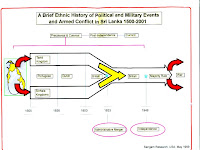A Brief Colonial History Of Ceylon(SriLanka)
Sri Lanka: One Island Two Nations
A Brief Colonial History Of Ceylon(SriLanka)
Sri Lanka: One Island Two Nations
(Full Story)
Search This Blog
Back to 500BC.
==========================
Thiranjala Weerasinghe sj.- One Island Two Nations
?????????????????????????????????????????????????Wednesday, July 30, 2014
The nightmare that ‘Black July’ conjures up
Where
to go for safety? Where to earn our livelihood? These were the
questions writ large on the faces of the Tamil refugees in July 1983.
Photo: The Hindu Archvies.
Though it is five years since the civil war ended, 69,000 Tamils continue to live as refugees
VIDYA VENKAT-July 30, 2014
The date was 25 July, 1983.
Only two days earlier, an ambush by the Liberation Tigers of Tamil Eelam
had claimed the lives of 13 Sri Lankan soldiers in Jaffna. The incident
sparked riots across Sri Lanka, in which mobs of Sinhala goons targeted
the Tamil minority community with government support. For the first
time, Tamils started leaving the island nation in large numbers.
Those who could afford it took the flight to India, while others braved the seas.
“I may not have survived to tell you this tale, had my Sinhala friends
not rescued me that day,” says Antony, looking back at the dark days of
the anti-Tamil pogrom from July 24 to 29, 1983, remembered as ‘Black
July’.
Antony’s brother Solomon* saw his brand new house in the Raddoluwa
Housing Scheme, near the Katunayake airport, being burnt down on July 29
after a rumour that the LTTE had poisoned the water tank.
He continues to preserve the half-burnt wedding photo, found hanging
from the sooty black wall of his home, when he went there a year later.
He lives with his family at Tuticorin now, and is apprehensive of going back.
Mary*, a resident of Muttuwal, Colombo, escaped to India at the age of 16, with her mother and four sisters.
“We lost everything,” she recalls. “After the assassination of Rajiv
Gandhi in 1991, surviving as a refugee in Tamil Nadu has not been easy
either.” Her eyes well up as she recalls the stigma of having to show up
at the police station every week to sign the register.
Such stories abound, and though it is five years since the civil war
ended, 69,000 Sri Lankan Tamils continue to live as refugees in 110
camps in 25 districts of Tamil Nadu.
They live in 10x10 feet homes, which have basic amenities; but,
livelihood concerns run deep. Desperate for a better life, people in
these camps often make futile attempts to escape to other countries.
Referring to the recent attempt at trafficking Sri Lankan refugees to
Australia, Antony says: “These incidents are quite common. The younger
generation of the refugees faces a bleak future.”
S.C. Chandrahasan, founder of the Organisation for Eelam Refugees
Rehabilitation (OfERR), started the NGO in Chennai in 1984 to work among
the displaced Sri Lankan community.
“One good thing is that owing to our intervention, the refugee children have attained 100 per cent literacy,” he says.
“The governments of India and Sri Lanka must expedite efforts to
rehabilitate the refugee families,” says Mr. Chandrahasan, who, too,
escaped to India in 1983.
Quoting from Kani Nilam Vendum, a poem by Subramanya Bharathi, he sums up the aspirations of his community:
“All I need is a small piece of land, oh divine mother, A small piece of land, and there,
In the midst of that small piece of land, build me a house with four pretty pillars and several floors near the small pond…”
(*Names of refugees have been changed in order to protect their identities.)
